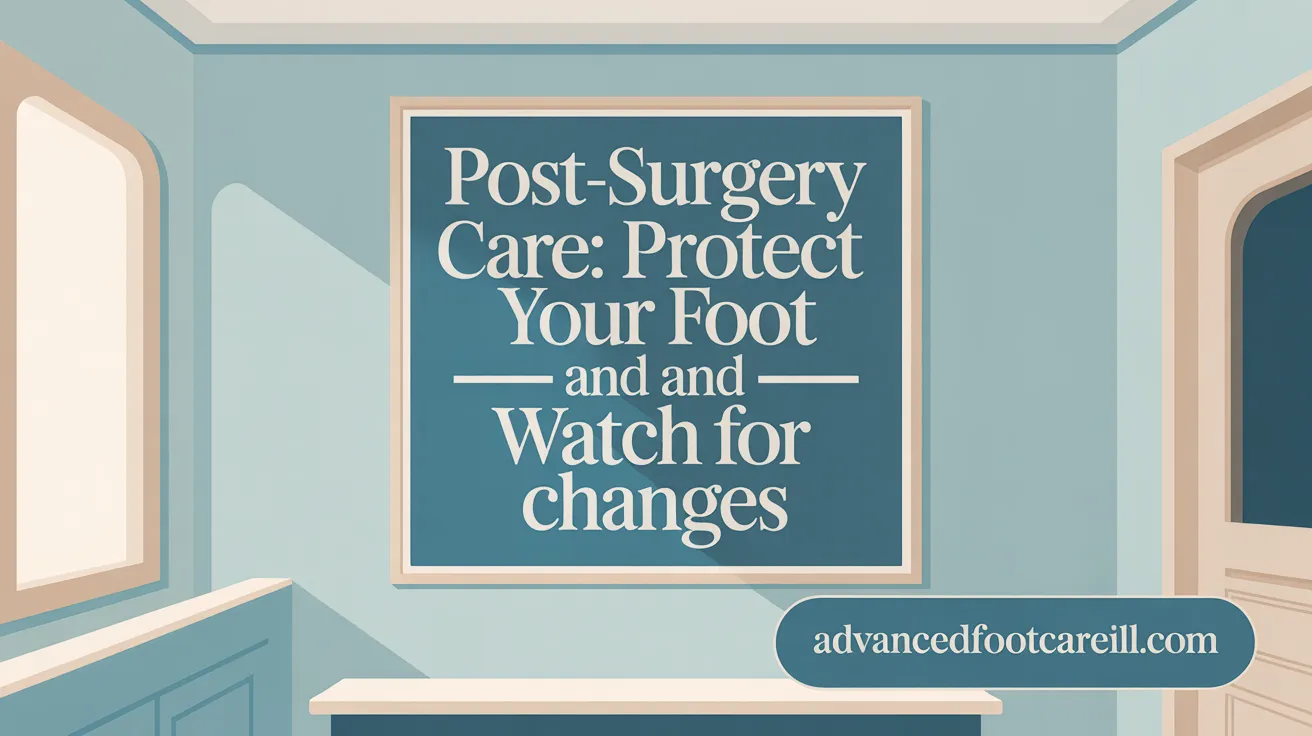Begin Your Recovery Journey Right
Recovering from foot surgery can feel overwhelming, but understanding the key steps to speed up healing and avoid complications can make all the difference. This guide offers expert advice on preparing for surgery, managing pain, performing effective rehabilitation, and creating a supportive home environment, ensuring your recovery is as smooth and speedy as possible.
Pre-Surgery Preparation and Post-Operative Planning

What should patients know about preparing for foot surgery and post-operative procedures?
Preparing for foot surgery involves understanding the details of the specific procedure, its expected benefits, and potential risks. Patients should have thorough discussions with their surgical team to clarify all aspects of the surgery, including anesthesia options and expected recovery timeline (Preparing for foot and ankle surgery, Risks of foot and ankle surgery).
Preoperative steps include stopping certain medications like blood thinners or hormone therapies, quitting smoking to improve blood flow and healing (Quitting smoking for better healing), and maintaining good foot hygiene by washing the feet and trimming toenails (Foot hygiene before surgery). Patients are often advised to fast for a period before surgery to reduce anesthesia risks (Preparing for foot and ankle surgery).
Home and support system setup are crucial. Patients should organize their living space by removing tripping hazards, installing safety features like grab bars and handrails (Clearing pathways to prevent falls, Using non-slip mats for safety), and creating a designated recovery area on a single level with essentials within reach (Home preparation for recovery). Arranging for help with daily tasks, transportation to and from the surgical center, and pet care can ease the recovery process (Home care tips for foot surgery recovery).
On the day of surgery, patients are typically asked to arrive early, wear loose, comfortable clothing, and bring essential documentation such as insurance cards and medications (Prepare for foot and ankle surgery). Post-surgery, it’s important to follow instructions on pain management, elevating the foot above heart level, and keeping the surgical site clean and dry (doctor's instructions for foot surgery recovery, Rest and elevation after surgery, Keeping surgical area clean and dry). Monitoring for signs of infection or complications and attending follow-up appointments are part of effective recovery (When to contact your surgeon, Follow-up appointments after surgery).
Setting realistic expectations is vital, as complete healing can take six months to a year, depending on the procedure and individual health (Healing timeline for foot and ankle surgery, Postoperative care for foot and ankle surgery). Patience, adherence to medical advice, and proactive communication with healthcare providers are essential to achieving optimal recovery outcomes (Importance of rest and patience in recovery, Tips for Faster Foot Surgery Recovery).
Essential Post-Surgical Care and Symptom Management

What are the best practices and instructions for post-surgical care after foot surgery?
Post-surgical foot care requires diligent attention to wound hygiene to prevent infection. Patients should keep the surgical dressings dry and monitor for signs of complications such as increased swelling, redness, abnormal drainage, or fever. Elevating the foot above the heart level during the initial phase reduces swelling and promotes healing. Using mobility aids like crutches or a walker helps avoid putting weight on the affected foot, while applying ice packs and taking prescribed medications effectively control pain and inflammation.
Follow-up appointments with the surgeon are vital to assess wound healing, remove dressings or casts, and adjust care plans. Gradually increasing activity levels with the guidance of healthcare providers—such as undertaking physical therapy exercises—supports the restoration of foot strength, flexibility, and function. Proper wound care, including keeping the incision site clean and dry, is essential; avoid soaking or exposing the wound to water until your doctor approves.
Patients should also be aware of what normal recovery looks like, such as the phases of healing that include the three-month adaptation phase, characterized by temporary swelling, redness, and discomfort, which usually resolves within a year. Recognizing warning signs—such as persistent pain, unusual swelling, foul-smelling discharge, or temperature spikes—is crucial to seek timely medical intervention and prevent serious complications.
In sum, conscientious wound management, adherence to activity restrictions, effective pain and swelling control methods, and attentive follow-up care collectively facilitate a safe and successful recovery after foot surgery.
Pain Management and Physical Therapy for Optimal Healing

What pain management strategies are effective during recovery from foot surgery?
Effective pain relief during recovery combines careful use of medications for pain management after foot surgery and supportive techniques. Patients are typically prescribed NSAIDs, like ibuprofen, for their anti-inflammatory and analgesic effects, which should be taken as directed. Short-term opioids may be used for more severe pain but only under close medical supervision to prevent dependency. Non-pharmacologic methods such as applying ice packs for inflammation for 20-minute intervals several times daily help reduce swelling and numbness, providing significant comfort. Elevating the foot to reduce swelling above heart level during the first 2-3 days minimizes swelling and alleviates pain. Maintaining an activity schedule that includes limiting unnecessary movement, especially avoiding standing or walking for extended periods, also helps diminish discomfort. Staying in regular contact with your healthcare provider ensures medications are effectively managed and that any signs of complications or worsening pain are promptly addressed, as emphasized in post-surgical care and pain management guidelines.
What types of exercises and physical therapy help facilitate healing after foot surgery?
Once initial healing phases are underway, a structured physical therapy program can significantly enhance recovery. Light, non-painful range-of-motion exercises such as ankle circles, alphabet writing with the toes, and towel stretches help maintain joint flexibility. Strengthening exercises should be introduced gradually, including calf raises, marble pickups, and resisted ankle movements, to rebuild muscle support around the foot and ankle. Balance training, like single-leg stands, improves proprioception and stability, reducing future injury risks. Before starting these exercises, warm-up activities like walking or stationary cycling for 5-10 minutes can prepare tissues and improve blood flow. All exercises should be performed within pain-free limits and under professional guidance to prevent overstressing healing tissues. Regularly doing these routines, about 3 to 7 days a week, alongside icing and elevation, can help this process, ultimately promoting tissue repair, reducing stiffness, and restoring function, as highlighted in post-operative rehabilitation advice and physical therapy for foot recovery.
Nutrition, Lifestyle, and Mental Well-being During Recovery

How can nutrition and lifestyle adjustments support recovery after foot surgery?
Proper nutrition and lifestyle changes play a vital role in optimizing healing after foot surgery. A balanced diet rich in proteins, including meats, eggs, beans, and nuts, supplies the building blocks for tissue and bone repair. Vitamins such as C and D, along with minerals like zinc and calcium, support immune function and inflammation reduction. Incorporating omega-3 fatty acids from fatty fish, nuts, and seeds can also help decrease inflammation. For detailed guidance, see Nutrition for foot surgery recovery.
Staying well-hydrated by drinking at least 8 glasses of water daily aids in flushing toxins and facilitates nutrient transport. Consuming anti-inflammatory foods and maintaining good overall nutrition accelerate recovery and reduce complication risks. Additionally, supporting overall health with adequate rest, minimizing stress, and avoiding smoking and alcohol can further promote effective healing. For more on lifestyle and nutritional support, refer to Living your best life after foot and ankle surgery.
Consulting healthcare professionals or dietitians can help tailor nutritional plans suitable for individual needs and recovery goals.
What strategies can aid mental and emotional support during recovery from foot surgery?
Recovery from foot surgery often involves physical restrictions that can lead to emotional challenges such as boredom, frustration, or anxiety. Engaging in activities like reading, watching movies, or hobbies that can be done sitting or lying down helps maintain mental stimulation and improve mood. Maintaining regular contact with loved ones provides emotional support and reduces feelings of isolation. For ideas on activities and mental well-being, see Keeping Yourself Sane After Foot Surgery.
Setting small, achievable goals and celebrating progress can boost confidence and motivation. Relaxation techniques such as mindfulness, meditation, or deep breathing exercises help manage stress. Educating oneself about the recovery process or joining support groups can provide reassurance and a sense of community. If feelings of depression or anxiety persist, seeking support from mental health professionals is important. Supporting mental well-being not only improves emotional health but also enhances physical recovery.
Creating a Supportive Home Environment and Long-Term Recovery Guidance
What home modifications and environment setups are recommended for post-surgical foot care?
Creating a safe and supportive home environment is crucial for successful recovery after foot surgery. Patients should remove tripping hazards such as loose rugs, clutter, and electrical cords. Installing safety features like grab bars, handrails on stairs, and nightlights helps prevent falls, especially during nighttime. Organizing essential items—medications, water, entertainment, and frequently used supplies—within easy reach minimizes unnecessary movement and strain. Elevating the surgical foot above heart level with pillows or supports reduces swelling and pain, and applying ice packs in a thin, tight bag over the surgical area can aid in inflammation control. Using assistive devices such as crutches, a walker, or a knee scooter, as recommended, facilitates mobility while keeping weight off the healing foot. Maintaining clean, dry conditions around the wound, adhering to wound care instructions, and monitoring for signs of infection or bleeding are essential. Planning for mobility with gradual physical therapy and supportive techniques helps promote healing and prevent complications.
What recommendations exist for post-surgical follow-up and ongoing medical guidance after foot surgery?
Regular follow-up appointments are vital for monitoring the healing process. These visits, typically scheduled 1-3 weeks after surgery, allow the healthcare provider to assess the surgical site, remove or adjust dressings, and evaluate progress with imaging or physical examination. Patients should report any unusual symptoms immediately, including increased pain, swelling, redness, pus, or systemic signs like fever. Adhering to prescribed physical therapy and activity restrictions ensures safe progression through recovery. Using supportive devices properly and gradually increasing weight-bearing activities as advised help restore function. Awareness of complications such as infection, blood clots, or POAP (post-operative inflammatory phase) is important. Nutritional support, including adequate hydration and a diet rich in vitamins, can improve healing. Maintenance of a healthy lifestyle, routine check-ups, and open communication with the healthcare team are essential for long-term recovery and prevention of future issues.
Key Takeaways for a Successful Foot Surgery Recovery
Successful recovery after foot surgery hinges on thorough preparation, diligent post-operative care, effective pain management, targeted rehabilitation, and maintaining a supportive living environment. Patience, adherence to medical guidance, and awareness of both physical and emotional wellbeing empower patients to navigate the healing journey successfully. With comprehensive care and realistic expectations, individuals can restore mobility and enjoy improved quality of life following their foot surgery.
